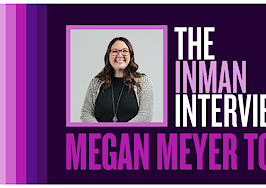Last week, Las Vegas real estate agent Sean Gotcher took on the iBuyers.
In a video on TikTok, Gotcher laid out a hypothetical scenario in which a large unnamed company that “everybody used” starts buying up homes in a neighborhood for $300,000. After buying up 30 houses though, the company in Gotcher’s scenario voluntarily pays $340,000 for an equivalent home, thus boosting the value of all the other properties.
“What that just did is create a new comp,” Gotcher says in the video. “So when they go to see these other 30 homes, that extra $40,000, that you can say this one just sold for $340,000, just made them $1.2 million.”
@seangotcher
What Gotcher is essentially describing is the potential for an iBuyer to fix prices. If a company owns all the houses in a given area, that company could arguably set prices for those homes independent of normal supply and demand. If you control the entire supply, the logic goes, people have to pay whatever you want.
Gotcher doesn’t mention a specific company by name, but shortly after the video went up it went viral. On TikTok, it generated more than 2 million views and 12,000 comments. Many of the commenters have suggested Zillow could pull off what Gotcher was describing, with others also pointing to companies such as Redfin and Opendoor.
But Redfin wasn’t having any of Gotcher’s arguments.
On Twitter — where the video has racked up more than 8,000 retweets — Redfin CEO Glenn Kelman plunged into the debate over the weekend. In a multi-tweet response, Kelman argued that Gotcher’s description of iBuying “is untrue” where Redfin is concerned.
Instead, Kelman argued, Redfin would “never intentionally underpay or overpay for a home,” adding that to do so in an attempt to boost the price of other houses would be “madness.”
1 of 6: Where Redfin's concerned, this is untrue. We offer every homeowner a choice of a cash offer or a brokered sale, sharing the data we use to price the home. We tell the owner he or she will net more money via a brokered sale. We would rather sell the home without owning it.
— Glenn Kelman (@glennkelman) September 18, 2021
In another tweet, Kelman also noted that Redfin “would rather sell the home without owning it.”
“We offer every homeowner a choice of a cash offer or a brokered sale, sharing the data we use to price the home,” Kelman said. “We tell the owner he or she will net more money via a brokered sale.”
Zillow also pushed back.
In a statement emailed to Inman Wednesday, the company characterized the video as an example of “misinformation and falsehoods.” The statement continued, saying “the simple truth is that through our services and tools, home shoppers have more power than ever before at their fingertips when buying, selling or renting their home because of the information we make available to them.”
“We pay market value for every home we purchase,” the statement added. “When we looked at homes that sold traditionally after they declined a Zillow Offer, we learned that on average, those selling traditionally sold for only .09 percent more than the Zillow Offer. And on every home that Zillow buys and sells, we are transparent: the purchase and re-sale prices are publicly displayed on the property page on Zillow.com.”
In addition, Zillow produced a report earlier this year that explored the overall state of the iBuying market. Significantly, the report found that in the second quarter of this year, iBuyers collectively had 1 percent of the U.S. home sales market. That’s no small feat and means iBuyers such as Zillow, Redfin, Opendoor and others bought more than 15,000 homes.
In some places, such as Phoenix, iBuyers had as much as 5 percent of the market.
Still, the sector’s share of the overall sales landscape is tiny. By comparison, numbers from the National Association of Realtors (NAR) show that the U.S. is also on track for more than 5 million sales this year.
Other reports have made similar points. Earlier this year real estate analyst Mike DelPrete showed that iBuyers market share plummeted during the early parts of the coronavirus pandemic. The companies since recovered and are doing more business than ever before, but even at the more recent high point their total market share is tiny.
The takeaway from all of this is that the scenario Gotcher’s video lays out does not appear to be the current reality. IBuying is too much of a niche product.
But that doesn’t answer the question of whether or not such a premise is theoretically possible at some future point. So, could an iBuyer scoop up all the homes in a neighborhood and then pull some sort of price-raising shenanigan?
For now, the answer appears to be that such a scenario is unlikely.

Mike DelPrete
In an email to Inman Wednesday, DelPrete described the premise of the video as “fairly conspiratorial.”
“Just because it’s possible doesn’t mean it’s probable,” he added.
There are a lot of factors that make the video’s premise improbable.
For one thing, with only 1 percent market share the iBuyers are years away from thoroughly dominating the sales market. And in the meantime, DelPrete has found that they’re actually paying above market prices for their properties — a fact that suggests the iBuyers are contending with significant competition.
It’s also unclear if any one iBuyer will ever emerge as the single monopolistic player in the space. While Opendoor has long been the dominant company, DelPrete found earlier this year that its lead over Zillow was down from 250 percent in 2019 to just 50 percent in March. Offerpad isn’t far behind Zillow, and many of real estate’s most established brands such as Realogy and Keller Williams, as well as some local brokerages and startups, have begun dipping their toes into iBuying as well.
The result is that the iBuying field is getting more crowded, not more monopolistic, which would severely limit any one company’s ability to artificially inflate prices.
It is perhaps illustrative at this point to look at online retail. Over the last several decades, Amazon has consumed much of that sector. When it comes to books, Amazon’s original focus, many competitors are either greatly diminished or gone entirely. But books — and indeed many other items Amazon now sells — aren’t significantly more expensive now than they were a decade ago. Moreover, Amazon still has many successful competitors such as Walmart, Target, Costco and Best Buy. Those companies are thriving.
There are many differences between Amazon and iBuyers, but the point is that even a company with Amazon’s clout still has to compete on pricing. And it’s difficult to imagine any single iBuyer eventually dominating real estate sales in a way that Amazon hasn’t been able to do in ecommerce.
None of this means, however, that iBuying isn’t disrupting real estate at a time when consumers are feeling a squeeze from rising prices and shrinking affordability. And in his response to the video, Kelman noted that Gotcher is right “that iBuyers are counter-parties, when consumers are used to dealing with brokers acting as fiduciaries.”

Glenn Kelman
“IBuyers sit on the opposite side of the table from the owner, not the same side. This is why Redfin could never be a pure iBuyer,” Kelman said.
Kelman also argued on Twitter that “there is a conspiracy between iBuyers, but it’s to pay lower commissions to the brokers representing the buyers of the homes we sell, by about 60 basis points so far.”
“This may be one reason some brokers dislike iBuyers,” he added.
In his email to Inman, DelPrete also indicated there are open questions about how iBuyers will ultimately impact consumers. For instance, he said “there are potential downsides for having a corporate middleman involved in a real estate transaction at scale.” He also pointed to a blog post in which he observed that Opendoor has at times withheld listings from the market.
“What happens when a company — backed by Wall Street and motivated by profit — has the ability to withhold listings from the market in the midst of a once-in-a-generation housing shortage?” DelPrete wondered in the post. “With the rise of new models that change the paradigm of home ownership, careful attention should be paid to a possible collision between what’s good for a company, and what’s good for the consumer.”








